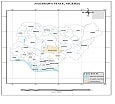Prevalence and Factors Responsible for Asymptomatic Malaria Reservoir of Plasmodium Falciparum Among Adults in Nasarawa State, Nigeria

Abstract:
Asymptomatic malaria is prevalent in highly endemic
areas of Africa, with only a small percentage of individuals exhibiting
clinical symptoms. The clinical consequence of asymptomatic malaria is not
fully understood. Some researchers are of the view that asymptomatic
parasitaemia is involved in the development of partial immunity and may protect
against clinical disease from new infections. The purpose of this study was to
assess the prevalence of malaria reservoir of plasmodium falciparum among adult
people of Nasarawa state of Nigeria and to identify the factors associated with
malaria in this category of people. A community-based cross-sectional
study was conducted among selected local government areas of the state. The
outcome variable was the presence or absence of malaria in which its
asscoiation with demographic information, knowledge and awareness, measures and
control, environmental factors are tested. The local government areas were
observed to have reported the highest positivity rate of malaria between 2017
to 2022. The study was conducted from August 2022 to April 2023. A
semi-structured questionnaire was employed to collect socio-demographic data
and other associated risk factors by trained health professionals. Body
temperature and other clinical manifestations were examined to identify the
asymptomatic individuals. This examination was carried out after selection of
individuals from households before mRDT is conducted. Data entry and analysis was
carried out using SPSS (Statistical Package for the Social Sciences) version 20
software. The results obtained are very desirable.
References:
[1] Christopher I.,
Alex B. Odaibo& David O.O., 2011, Impact of Asymptomatic Malaria on Some
Hematological Parameters in the Iwo Community in Southwestern Nigeria, Med
Princ Pract 2011;20:459–463, DOI: 10.1159/000327673. Avalable at https://www.academia.edu/52627888/Impact_of_Asymptomatic_Malaria_on_Some_Hematol
ogical_Parameters_in_the_Iwo_Community_in_Southwestern_Nigeria
[2] Moonen B, Cohen J.
M, Snow R. W, Slutsker L, Drakeley C, Smith D. L, Abeyasinghe RR, Rodriguez M.
H, Maharaj R, Tanner M, Targett G, 2010, Operational strategies to achieve and
maintain malaria elimi-nation. Lancet. 376(9752):
1592–603.DOI: https//10.1016/s0140-6736 (10), 61269-X
[3] Olukemi K. Amodu, Obioma C. Uchendu, 2014, https://www.researchgate.net/publication/271533876_Differences_in_the_Malariometric_Indices_of_Asymptomatic_Carriers_in_Three_Communities_in_Ibadan_Nigeria
[4]
World
Health Organization , 2020, World Malaria Report 2020. Available at https://www.who.int/publications/i/item/9789240015791
[5] Okafor F.U., and Oko-Ose J. N., 2012,
Prevalence of malaria infections among children agedsix months to eleven years
(6 months-11 years) in atertiary institution in Benin City, Nigeria. Global
Advanced Research Journal of Medicine and Medical Sciences, 1(10):
273-279
[6] U.S. President’s
Malaria Initiative (PMI): Nigeria Malaria Operational Plan FY 2023. Available
at htpps://www.pmi.gov
[7] Ukpong I. G., Etim S. E., Ogban E.
I., and Abua L. L., 2015, Prevalence of Malaria in the Highlands of Obudu
Cattle Ranch, Nigeria, International Journal of Tropical Disease and Health,7(3):
87-93, https://doi.org/10.9734/IJTDH/2015/14609
[8]
Wagbatsoma,
V. A. and Ogbeide, O.,1995, Towards malaria control in Nigeria: A qualitative
study on population of mosquitoes. The Journal of the Royal Society for the
Promotion of Health, Vol. 115, No. 6, pp. 363–365. DOI: https://dx.doi.org/10.1177/146642409511500607
[9]
Nwaneri
D. U, Adeleye O. A, Ande A. B, Asymptomatic malaria parasitaemia using rapid
diagnostic test in unbooked pregnant women in rural Ondo-south district , Nigeria.
J Prev Med Hyg. 2013;54:49–52.
[10]
Ellis
Kobina Paintsil, Akoto Yaw Omari-Sasu, Matthew Glover Addo, and Maxwell
Akwasi Boateng et al, 2019, Analysis of Haematological Parameters as Predictors
of Malaria Infection Using a Logistic Regression Model: A Case Study of a
Hospital in the Ashanti Region of Ghana. Hindawi Malaria Research and
Treatment Volume 2019, Article ID 1486370, 7 pages, available at https://doi.org/10.1155/2019/1486370
[11]
Severe
Malaria Observatory , 2020, Knowledge sharing for malaria. Available at https://www.severemalaria.org/countries/nigeria
[12]
World
HealthOrganization , 2021, World Malaria Report 2021. Available at https://www.who.int/news
room/fact-sheets/detail/malaria. Trans R Soc Trop Med Hyg; 93: 50–53. 4 Desai
[13]
Robert Herriman, 2023, Nigeria
approves R21 Malaria Vaccine. Available at https://www.nafdac.gov.ng/press-briefing-by-prof-mojisola-christianah-adeyeye-director-general-national-agency-for-food-and-drug-administration-and-control-nafdac-on-the-regulatory-approval-of-r21-malaria-vaccine-by-nafdac/
[15]
National Population Commission (NPC, 2019). Nigeria
Demographic and Health Survey 2018.Abuja, Nigeria, and Rockville, Maryland,
USA: NPC and ICF.
[16]
IRI
Database, (2006): International Research Institute for Climate & Society
(IRI), Lamont Campus, Palisades, New York: The Earth Institute at Columbia
University.
[17]
World
Health Organization, 2021, WHO list of Prequalified in vitro diagnostic
products 2021. https://extranet.who.int/pqweb/sites/default/files/documents/210309_prequalified_product_list.pdf
[19] National Bureau for Statistics, 2019,
Poverty and Inequality in Nigeria: executive summary 2020. Available at
https://www.nigerianstat.gov.ng
[20] Alsan, Marcella
M.; Westerhaus, Michael; Herce, Michael; Nakashima, Koji; Farmer, Paul E.
(2011). "Poverty, Global Health, and Infectious Disease: Lessons from
Haiti and Rwanda" https://www.ncbi. nlm.nih.gov/pmc/articles/PMC3168775
[21]
James
Cheaveau, Daniel Castaneda Mogollon, Md Abu Naser Mohon, Lemu Golassa,
Delenasaw Yewhalaw& Dylan R Pillai (2019): Asymptomatic malariain the
clinical and public health context, Expert Review of Anti-infective Therapy,
DOI: 10.1080/14787210.2019.1693259. available at
https://doi.org/10.1080/14787210.2019.1693259
[23]
Ignatius C. N., Daniel Okyere, Juliana Yartey Enos, et
al., 2019, Prevalence of asymptomatic malaria parasitaemia following mass
testing and treatment in Pakro sub-district of Ghana. 2019; 19:1622. DOI: https://10.1186/s12889-009-7986-4

